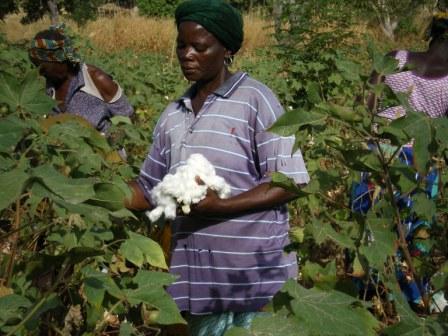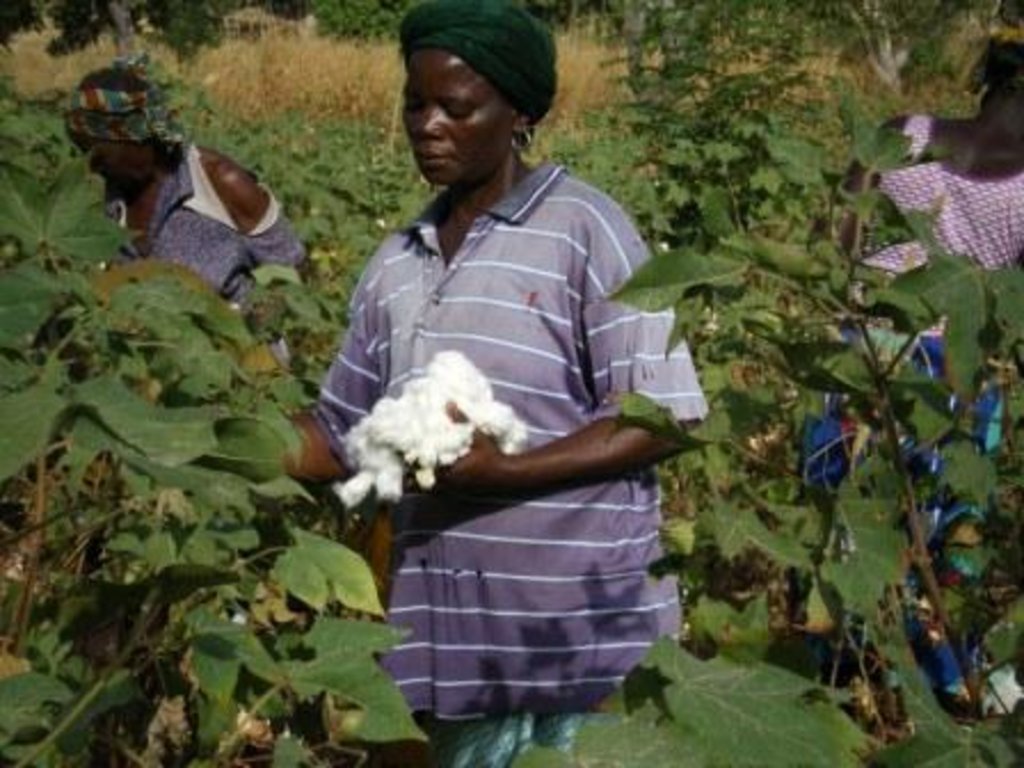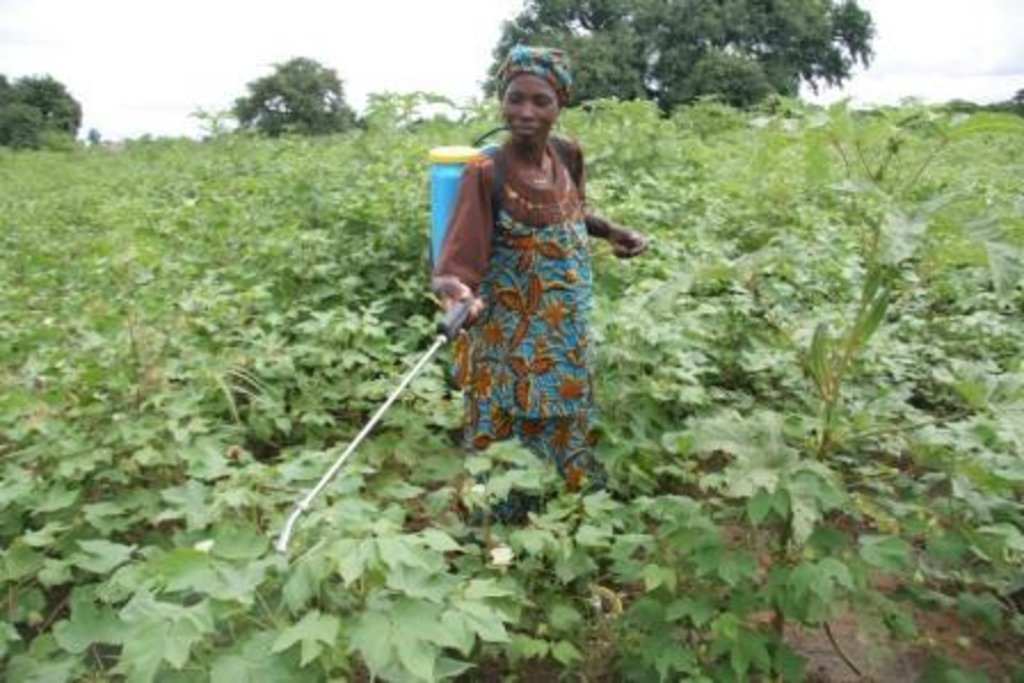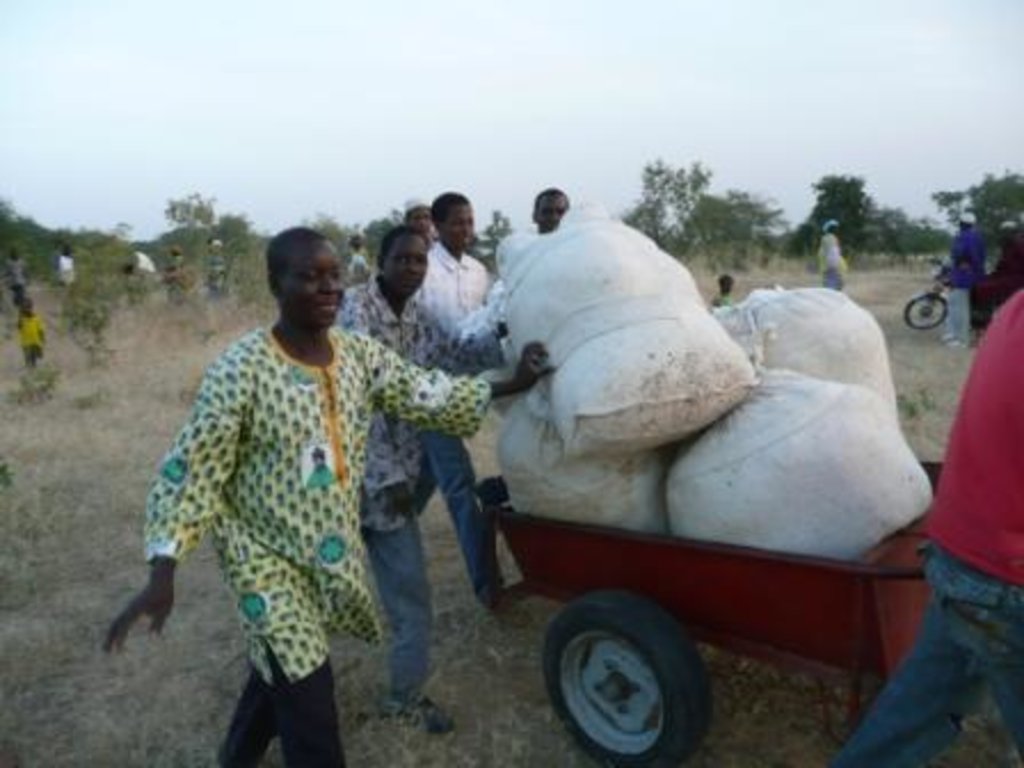Organic cotton [ប្រទេសបួគីណាហ្វាសូ]
- ការបង្កើត៖
- បច្ចុប្បន្នភាព
- អ្នកចងក្រង៖ Julie Zähringer
- អ្នកកែសម្រួល៖ –
- អ្នកត្រួតពិនិត្យ Alexandra Gavilano
technologies_957 - ប្រទេសបួគីណាហ្វាសូ
ពិនិត្យមើលគ្រប់ផ្នែក
ពង្រីកមើលទាំងអស់ បង្រួមទាំងអស់1. ព័ត៌មានទូទៅ
1.3 លក្ខខណ្ឌទាក់ទងទៅនឹងការប្រើប្រាស់ទិន្នន័យដែលបានចងក្រងតាមរយៈ វ៉ូខេត
អ្នកចងក្រង និង(បុគ្គលសំខាន់ៗ)យល់ព្រមទទួលយកនូវលក្ខខណ្ឌនានាទាក់ទងទៅនឹងការប្រើប្រាស់ទិន្នន័យដែលបានចងក្រងតាមរយៈវ៉ូខេត:
បាទ/ចា៎
2. ការពណ៌នាពីបច្ចេកទេស SLM
2.1 ការពណ៌នាដោយសង្ខេបពីបច្ចេកទេស
និយមន័យបច្ចេកទេស:
In the Loba province of Burkina Faso, the production, storage, processing and marketing of organic cotton has been promoted since 2004 by Helvetas.
2.2 ការពណ៌នាលម្អិតពីបច្ចេកទេស
ការពណ៌នា:
Organic cotton production adheres to the principles and standards of organic farming. Any application of synthetic fertilizers and pesticides and the use of genetically modified varieties are forbidden. Organic cotton relies on a combination of different measures: (1) the use of organic fertilizers (manure or compost) and recycling of organic matter; (2) Crop rotation and/or intercropping; (3) Careful selection of varieties adapted to local conditions (climate, soil, pests and diseases); (4) Biological pest management (in combination with careful monitoring of crops); (5) Clear separation of organic and conventional cropland, e.g. by growing border crops (to avoid contact with chemical substances through spray drift or surface runoff); and (6) Soil and water conservation measures. Timely crop management (e.g. weeding) is very important. In Loba rotations crops include sesame (a cash crop), cereals and legumes (food crops), while intercrops include leguminous green manure and trap plants. The best adapted cotton variety is FK-37. Bio-pesticides are produced based on neem seeds (Azadirachta indica). The measures listed above help to improve soil fertility, reduce production costs (and thus financial risk) and avoid the negative effects of conventional farming: declining yields, resistance to pests and diseases, health hazards and environmental problems caused through the use of chemicals. By relying on inputs available/produced on the farm and by getting a better price for certified organic products, profitability of the farm is improved in the long run despite of lower productivity compared to conventional or genetically modified (GM) cotton. Farms need to complete a 3-year conversion period to change their production system from conventional to organic. Farmers have to maintain records and documents for periodic inspection and certification (Internal control system).
2.3 រូបភាពនៃបច្ចេកទេស
2.5 ប្រទេស/តំបន់/ទីតាំងកន្លែង ដែលបច្ចេកទេសត្រូវបានអនុវត្ត និងបានគ្រប់ដណ្តប់ដោយការវាយតម្លៃនេះ
ប្រទេស:
ប្រទេសបួគីណាហ្វាសូ
តំបន់/រដ្ឋ/ខេត្ត:
Ioba province
បញ្ជាក់បន្ថែមពីលក្ខណៈនៃទីតាំង:
Dano
2.6 កាលបរិច្ឆេទនៃការអនុវត្ត
ប្រសិនបើមិនច្បាស់ឆ្នាំ សូមបញ្ជាក់កាលបរិច្ឆេទដែលប្រហាក់ប្រហែល:
- តិចជាង 10ឆ្នាំមុន (ថ្មី)
2.7 ការណែនាំពីបច្ចេកទេស
សូមបញ្ជាក់តើបច្ចេកទេសត្រូវបានណែនាំឱ្យអនុវត្តដោយរបៀបណា:
- តាមរយៈគម្រោង / អន្តរាគមន៍ពីខាងក្រៅ
3. ចំណាត់ថ្នាក់នៃបច្ចេកទេស SLM
3.2 ប្រភេទដីប្រើប្រាស់មួយប្រភេទ (ច្រើនប្រភេទ) ដែលបានអនុវត្តបច្ចេកទេស

ដីដាំដំណាំ
- ដំណាំរយៈពេលវែង (មិនមែនឈើ)
មតិយោបល់:
Major land use problems (land users’ perception): Fertility decline and reduced OM content; Biodiversity decline
3.3 ព័ត៌មានបន្ថែមអំពីអ្នកប្រើប្រាស់ដី
ការផ្គត់ផ្គង់ទឹកនៅកន្លែងអនុវត្តបច្ចេកទេស:
- ទឹកភ្លៀង
3.5 ការសាយភាយនៃបច្ចេកទេស
មតិយោបល់:
around 7'000 farmers
3.6 វិធានការ SLM ដែលបញ្ចូលនូវបច្ចេកទេស

វិធានការក្សេត្រសាស្ត្រ
- A2: សារធាតុសរីរាង្គ/ជីជាតិដី
មតិយោបល់:
Main measures: agronomic measures
Type of agronomic measures: mixed cropping / intercropping, legume inter-planting, manure / compost / residues
3.7 កំណត់ប្រភេទនៃការធ្លាក់ចុះគុណភាពដីសំខាន់ៗដែលបច្ចេកទេសនេះបានដោះស្រាយ

ការធ្លាក់ចុះសារធាតុគីមីក្នុងដី
- Cn: ការថយចុះជីជាតិ និងកាត់បន្ថយបរិមាណសារធាតុសរីរាង្គ (មិនកើតឡើងដោយការហូរច្រោះទេ)

ការធ្លាក់ចុះជីវសាស្ត្រនៃដី
- Bs: សមាសភាពដែលមានគុណភាពនិងប្រភេទសត្វ/ការថយចុះនូវជីវចម្រុះ
មតិយោបល់:
Main type of degradation addressed: Cn: fertility decline and reduced organic matter content, Bs: quality and species composition /diversity decline
3.8 ការពារ កាត់បន្ថយ ឬស្តារឡើងវិញនៃការធ្លាក់ចុះគុណភាពដី
បញ្ជាក់ពីគោលដៅរបស់បច្ចេកទេស ដែលផ្តោតទៅការធ្លាក់ចុះគុណភាពដី:
- ការកាត់បន្ថយការធ្លាក់ចុះគុណភាពដី
- ការការពារការធ្លាក់ចុះគុណភាពដី
មតិយោបល់:
Main goals: prevention of land degradation, mitigation / reduction of land degradation
4. បច្ចេកទេសជាក់លាក់ សកម្មភាពអនុវត្ត ធាតុចូល និងថ្លៃដើម
4.2 លក្ខណៈពិសេសនៃបច្ចេកទេស/ ពណ៌នាពីគំនូរបច្ចេកទេស
Technical knowledge required for field staff / advisors: high
Technical knowledge required for land users: moderate
Main technical functions: improvement of ground cover, increase in organic matter, increase in nutrient availability (supply, recycling,…), promotion of vegetation species and varieties (quality, eg palatable fodder)
Secondary technical functions: improvement of water quality, buffering / filtering water
Mixed cropping / intercropping
Material/ species: intercrops include leguminous green manure and trap plants
Manure / compost / residues
Material/ species: manure or compost
Agronomic measure: bio-pesticides
Material/ species: from Neem seeds (Azadirachta indica)
4.6 សកម្មភាពថែទាំ
| សកម្មភាព | ប្រភេទវិធានការ | ពេលវេលា/ ភាពញឹកញាប់ | |
|---|---|---|---|
| 1. | Compost production / Clear crop residues on fields where cotton will be planted, use for mulch or compost production (no burning) | ក្សេត្រសាស្ត្រ | |
| 2. | Apply organic manure: 7.5 t/ha / Ploughing (for incorporation of manure, pest and weed control) | ក្សេត្រសាស្ត្រ | |
| 3. | Sow cotton and intercrops (such as Hibiscus esculentus – a trap plant for pests; or Mucuna – a green manure plant); Thin out cotton after 10-20 days (1-2 plants per pocket) | ក្សេត្រសាស្ត្រ | |
| 4. | Weeding (3 to 4 times: 20/40/70/100days after sowing) / Pest control (manual collection); Spraying of bio-pesticide (64 liters / ha, based on neem seeds): according to infestation: up to 3 times | ក្សេត្រសាស្ត្រ | |
| 5. | Ridging (form furrows and ridges using plough or manually) / Pre-harvest weeding / Harvesting / Cut cotton stems / residues and incorporate into the soil | ក្សេត្រសាស្ត្រ |
4.7 កំណត់ថ្លៃដើមសម្រាប់ការថែទាំ/ សកម្មភាពរបស់បច្ចេកទេស (ក្នុងរយៈពេលមួយឆ្នាំ)
មតិយោបល់:
Machinery/ tools: hoe, plough, wheel-barrow, knapsack
4.8 កត្តាសំខាន់បំផុតដែលមានឥទ្ធិពលដល់ការចំណាយ
ពណ៌នាពីកត្តាប៉ះពាល់ចម្បងៗទៅលើថ្លៃដើម:
Standard equipment (hoe, plough, wheel-barrow) is not included in costs, knapsack is provided by producer’s association (UNPCB) on credit; transport bags are donated. Labour and other inputs for erosion control measures (e.g. stone bunds) are not included in costs. Neem biocide costs US$ 0.7 per liter; organic cotton seeds cost US$ 1.7 per 50 kg.
5. លក្ខណៈបរិស្ថានធម្មជាតិ និងមនុស្ស
5.1 អាកាសធាតុ
បរិមាណទឹកភ្លៀងប្រចាំឆ្នាំ
- < 250 មម
- 251-500 មម
- 501-750 មម
- 751-1,000 មម
- 1,001-1,500 មម
- 1,501-2,000 មម
- 2,001-3,000 មម
- 3,001-4,000 មម
- > 4,000 មម
តំបន់កសិអាកាសធាតុ
- មានភ្លៀងតិចតួច
Thermal climate class: tropics. tropical, with high rainfall variability
5.2 សណ្ឋានដី
ជម្រាលជាមធ្យម:
- រាបស្មើ (0-2%)
- ជម្រាលតិចតួច (3-5%)
- មធ្យម (6-10%)
- ជម្រាលខ្ពស់បន្តិច (11-15%)
- ទីទួល (16-30%)
- ទីទួលចោត (31-60%)
- ទីទួលចោតខ្លាំង (>60%)
ទម្រង់ដី:
- ខ្ពង់រាប
- កំពូលភ្នំ
- ជម្រាលភ្នំ
- ជម្រាលទួល
- ជម្រាលជើងភ្នំ
- បាតជ្រលងភ្នំ
តំបន់តាមរយៈកម្ពស់ :
- 0-100 ម
- 101-500 ម
- 501-1,000 ម
- 1,001-1,500 ម
- 1,501-2,000 ម
- 2,001-2,500 ម
- 2,501-3,000 ម
- 3,001-4,000 ម
- > 4,000 ម
5.3 ដី
ជម្រៅដីជាមធ្យម:
- រាក់ខ្លាំង (0-20 សម)
- រាក់ (21-50 សម)
- មធ្យម (51-80 សម)
- ជ្រៅ (81-120 សម)
- ជ្រៅខ្លាំង (> 120 សម)
វាយនភាពដី (ស្រទាប់លើ):
- ម៉ត់/ ធ្ងន់ (ឥដ្ឋ)
- គ្រើម/ មានពន្លឺ (ខ្សាច់)
សារធាតុសរីរាង្គនៅស្រទាប់ដីខាងលើ:
- មធ្យម (1-3%)
5.6 លក្ខណៈនៃអ្នកប្រើប្រាស់ដីដែលអនុវត្តបច្ចេកទេស
ទីផ្សារនៃប្រព័ន្ធផលិតកម្ម:
- ពាក់កណ្តាលពាណិជ្ជកម្ម (ផ្គត់ផ្គង់ខ្លួនឯង/ ពាណិជ្ជកម្ម
ឯកជន ឬក្រុម:
- ធ្វើខ្លួនឯង/ គ្រួសារ
កម្រិតប្រើប្រាស់គ្រឿងយន្ត:
- ប្រើកម្លាំងពលកម្ម
- ប្រើកម្លាំងសត្វ
សូមបញ្ជាក់ពីលក្ខណៈពាក់ព័ន្ធផ្សេងទៀតអំពីអ្នកប្រើប្រាស់ដី:
Difference in the involvement of women and men: certain activities carried out in mutual help groups
Population density: 50-100 persons/km2
5.7 ទំហំផ្ទៃដីជាមធ្យមនៃដីផ្ទាល់ខ្លួន ឬជួលគេដែលបានអនុវត្តបច្ចេកទេស
- < 0.5 ហិកតា
- 0.5-1 ហិកតា
- 1-2 ហិកតា
- 2-5 ហិកតា
- 5-15 ហិកតា
- 15-50 ហិកតា
- 50-100 ហិកតា
- 100-500 ហិកតា
- 500-1,000 ហិកតា
- 1,000-10,000 ហិកតា
- > 10,000 ហិកតា
តើផ្ទៃដីនេះចាត់ទុកជាទំហំកម្រិតណាដែរ ខ្នាតតូច មធ្យម ឬខ្នាតធំ (ធៀបនឹងបរិបទតំបន់)?
- ខ្នាតតូច
5.8 ភាពជាម្ចាស់ដី កម្មសិទ្ធប្រើប្រាស់ដី និងកម្មសិទ្ធប្រើប្រាស់ទឹក
ភាពជាម្ចាស់ដី:
- រដ្ឋ
កម្មសិទ្ធិប្រើប្រាស់ដី:
- ឯកជន
មតិយោបល់:
group (family clans) / state
6. ផលប៉ះពាល់ និងការសន្និដ្ឋាន
6.1 ផលប៉ះពាល់ក្នុងបរិវេណអនុវត្តបច្ចេកទេសដែលកើតមាន
ផលប៉ះពាល់លើសេដ្ឋកិច្ចសង្គម
ចំណូល និងថ្លៃដើម
ចំណូលក្នុងកសិដ្ឋាន
ផលប៉ះពាល់ទៅលើវប្បធម៌សង្គម
ស្ថានភាពសុខភាព
ផលប៉ះពាល់ទៅលើអេកូឡូស៊ី
ដី
វដ្តនៃសារធាតុចិញ្ចឹម/ការទទួលបាន
សារធាតុសរីរាង្គដី/ការបូនក្រោមដី
ជីវចម្រុះ៖ ដំណាំ, សត្វ
ប្រភេទសត្វមានប្រយោជន៍
6.3 ភាពប្រឈម និងភាពរួសនៃបច្ចេកទេសទៅនឹងការប្រែប្រួលអាកាសធាតុ និងគ្រោះអាកាសធាតុ/ គ្រោះមហន្តរាយ (ដែលដឹងដោយអ្នកប្រើប្រាស់ដី)
មតិយោបល់:
Tolerant to climatic extremes due to higher water retention capacity of soils, reduced erosion and crop diversification (reduced risk of total crop failure)
6.4 ការវិភាគថ្លៃដើម និងអត្ថប្រយោជន៍
តើផលចំណេញ និងថ្លៃដើមត្រូវបានប្រៀបធៀបគ្នាយ៉ាងដូចម្តេច (ទស្សនៈរបស់អ្នកប្រើប្រាស់ដី)?
រយៈពេលខ្លី:
អវិជ្ជមាន
រយៈពេលវែង:
វិជ្ជមានតិចតួច
តើផលចំណេញ និងការថែទាំ/ ជួសជុលត្រូវបានប្រៀបធៀបគ្នាយ៉ាងដូចម្តេច (ទស្សនៈរបស់អ្នកប្រើប្រាស់ដី)?
រយៈពេលខ្លី:
វិជ្ជមាន
រយៈពេលវែង:
វិជ្ជមានខ្លាំង
មតិយោបល់:
Establishment costs are higher than revenues due to investments & initial decrease in yield (conversion period). On the long term, advanced farmers can achieve same or even higher yields than conventional cotton systems
6.5 ការទទួលយកបច្ចេកទេស
មតិយោបល់:
100% of land user families have adopted the Technology with external material support
Comments on adoption trend: The proportion of organic cotton is growing
6.7 ភាពខ្លាំង/ គុណសម្បត្តិ/ ឱកាសនៃបច្ចេកទេស
| ភាពខ្លាំង/ គុណសម្បត្តិ/ ឱកាស ទស្សនៈរបស់បុគ្គលសំខាន់ៗ |
|---|
| This technology helps to improve soil fertility, reduce production costs (and thus financial risk) and avoid the negative effects of conventional farming: declining yields, resistance to pests and diseases, health hazards and environmental problems caused through the use of chemicals |
6.8 ភាពខ្សោយ/ គុណវិបត្តិ/ ហានិភ័យនៃបច្ចេកទេស និងវិធីសាស្ត្រដោះស្រាយ
| ភាពខ្សោយ/ គុណវិបត្តិ/ ហានិភ័យ ទស្សនៈរបស់អ្នកប្រើប្រាស់ដី | តើបច្ចេកទេសទាំងនោះបានដោះស្រាយបញ្ហាដូចម្តេច? |
|---|---|
| Lack of water | establish water retention structures |
| ភាពខ្សោយ/ គុណវិបត្តិ/ ហានិភ័យ ទស្សនៈរបស់អ្នកចងក្រងឬបុគ្គលសំខាន់ៗ | តើបច្ចេកទេសទាំងនោះបានដោះស្រាយបញ្ហាដូចម្តេច? |
|---|---|
| Coexistence of organic and GMO cotton resulting in high risk of contamination | intensify training of farmers; set up a coordination platform between organic and GMO farms; GMO communication plan; establish a sampling & testing system |
| Insufficient application of manure / compost | training on compost production; promote supply of organic manure (e.g. through SMEs specialized in compost production). |
| Large distance to cotton fields (resulting in high transportation costs) due to interfering of browsing livestock close to village | hay-making and corralling of livestock. |
| Lack of land, land ownership and land security | promote land leasing; resolve tenure problem on political level. |
| Lack of equipment (e.g. plough) | Develop and maintain access to credits for small-scale farmers. |
7. ឯកសារយោង និងវេបសាយ
7.2 ឯកសារយោងដែលបានចេញផ្សាយ
ចំណងជើង អ្នកនិពន្ធ ឆ្នាំ ISBN:
Helvetas. 2008. Guide de production - Un manuel de reference (Authors: Ouedraogo A, Yombi L, Doumbia S, Eyhorn F, Dischl R)
ចំណងជើង អ្នកនិពន្ធ ឆ្នាំ ISBN:
Eyhorn F., S.G. Ratter, M. Ramakrishnan. 2005. Organic Cotton Crop Guide – A Manual for Practitioners in the Tropics; Research Institute of Organic Agriculture FiBL, Frick, Switzerland
ការតភ្ជាប់ និងម៉ូឌុល
ពង្រីកមើលទាំងអស់ បង្រួមទាំងអស់ការតភ្ជាប់
គ្មានការតភ្ជាប់
ម៉ូឌុល
គ្មានម៉ូឌុល







